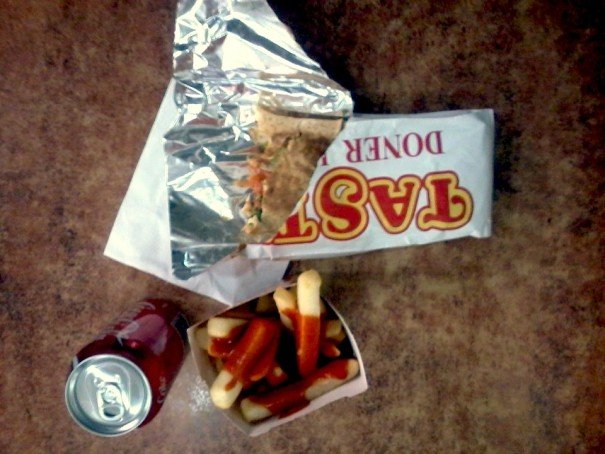
A Breakfast of Adorable Animals Is Reserved for Special Occasions

A Breakfast of Adorable Animals Is Reserved for Special Occasions
Kangaroo Kebabs in Australia
Kangaroos are skittish, although it’s not impossible to domesticate them. But usually the only view you’ll get of wild kangaroos is from behind. Walking through the bush, humps of dirt will suddenly rise up, shake themselves off and transform into a fleeing mob of Eastern Greys.
The only docile, wild kangaroo I’ve ever seen was standing in a creek, near-catatonic. A deep furrow on the back of its neck, with a fringe of bone sticking out, indicated that someone had taken a shot at it and only scored half a hit. Maggots the size of caterpillars were nesting in the wound.
This morning I’m eating kangaroo kebab, (although I prefer a thin roo steak, flash-fried; charred on the outside and rare on the inside). This is a kebab as Australians and Europeans know it: lumps of processed meat grilled on a vertical spit, served in a flatbread with tabouli or vegetables. It was introduced during the waves of Levantine immigration that followed WW2, when Greeks, Turks, Lebanese, and Egyptians flowed into Australia, melding and contrasting with the Anglo-Celtic society they found, and became a late night (or early morning) staple for revelers.
The reluctance of Australians and foreigners alike to chow down on a kangaroo sandwich can partially be attributed to squeamishness. Kangaroos are cute—cuter than cows or pigs—and although indigenous Australians and colonial settlers alike had no qualms about a roo-tail stew, the animal fell out of favor for a while. In recent years, it’s come back into the public eye, and can be found as burgers or “kanga bangas” in the produce aisle and on the menus of fine dining establishments.
Nonetheless, kangaroo is still reserved for special occasions, (like a greasy breakfast after a night out). Per capita, Australians consume nearly 250 pounds of red meat annually, which goes some way to explaining our world-beating rates of obesity and greenhouse gas emissions. Kangaroos, with their low fat-to-muscle ratio and methane-free flatulence, provide a fantastic alternative to sheep and cattle, particularly in dry, fragile environments.
This low demand, and the inevitable difficulty of farming an animal with the flight instincts and agility of a velociraptor, means there’s no real kangaroo husbandry industry. Almost all of the meat is produced during culls half-heartedly endorsed by the RSPCA, with strict controls for disease and pests.
However, as my maggoty friend demonstrated, roo shooting—or “spotlighting”—is a popular pastime with or without the meat. In large numbers, kangaroos can infringe on farmland, and preventative action is taken ad-hoc. Classic Ozploitation films like Wake in Fright and Razorback circle around the horror and ecstasy of a roo shoot. A variation on the theme, Welcome to Woop Woop, instead features the apocryphal legend of using roadkill kangaroos for meat.
At this greasy spoon in the heart of the central entertainment district, most of the clientele are curious backpackers looking to tick another bit of Australiana off their list after a night on the turps. Understandably, discussions are not centered on ecology, nutrition, culinary history nor ethical consumption. Kangaroo is a gimmick here: the kebabs aren’t terrible, but most of the flavor is salt, oil, garlic and chili rather the beefy, gamey taste of a good roo steak.